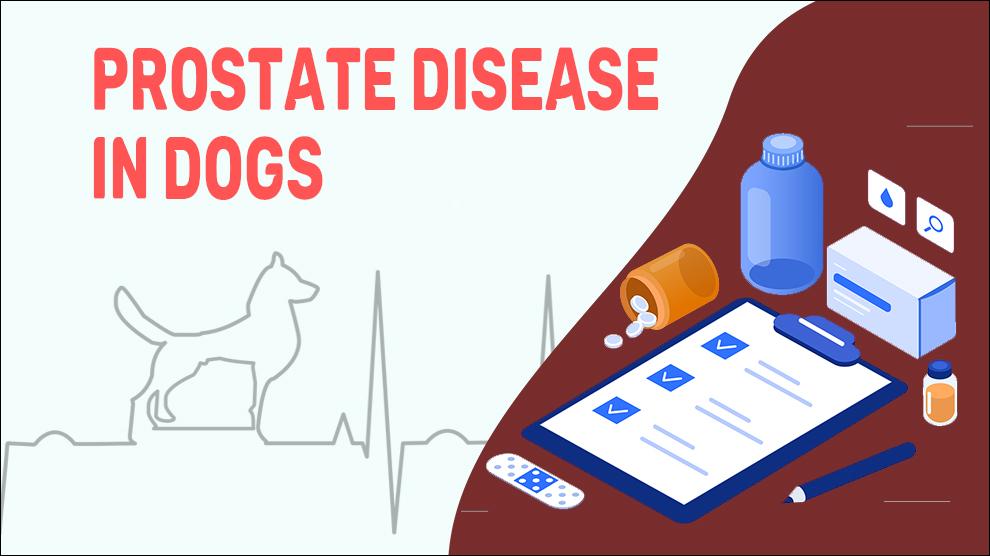Prostate is a bilobed, oval, sole male accessory sex gland located in the pelvic cavity of adult dogs below the rectum and behind the bladder, and it secretes seminal plasma components. The prostate gland surrounds the proximal part of the urethra and the neck of the bladder. Roughly the size of a walnut, the adult dog prostate gland weighs an average of 15- 20g.
Prostate gets affected by different types of diseases, both benign and malignant. Benign prostatic hyperplasia develops and it is similar to benign prostatic hyperplasia (BPH) in older men. The long-term effect of testosterone causes prostate enlargement; also called as benign prostatic hypertrophy, this is a premalignant condition especially in neutered dogs.
Sometimes, the dog’s prostate gland gets abnormally enlarged and it is medically referred to as prostatomegaly. Prostatitis is painful inflammation of prostate gland in dogs and it can occur suddenly (acute) or can develop silently over time (chronic).
Transitional cell carcinoma (ductal and urothelium instead of acinar epithelium neoplasia) is more prevalent in neutered male dogs.
Canine prostatic adenocarcinoma is the most common type of prostate cancer in dogs and it accounts for more than 80 percent of prostate cancer diagnoses. Neutered dogs may present a greater chance of developing prostatic adenocarcinoma, almost 3 times greater than non-neutered dogs.
Other rare types of malignant cancers that affect prostate are fibrosarcoma, Carcinoma, squamous cell carcinoma and leiomyosarcoma.
Symptoms Of Prostate Disease
General symptoms of prostate diseases are
- Hematuria (Blood in the urine)
- Stranguria/dysuria (Difficulty urinating )
- Frequent attempts to urinate
- Abnormal posture (especially while urinating)
- constipation, obstipation, dyschezia, tenesmus
- Abnormal gait with short steps
- Pain/General weakness
- Fever
- Weight loss
Treatment Options For Prostate Disease
Your vet may recommend diagnostic tests depending on your dog’s health, current symptoms, and medical history.
Depending on the underlying cause, vets may recommend a combination of treatments.
When your dog is diagnosed with prostate cancer your vet may recommend surgery, chemotherapy, radiation, or a combination of these treatments.
Treatment is not required for acute cases of dogs that are asymptomatic and those that have a good quality of life. Long-term management of Cancerous conditions depends on the overall health of dogs.
For prostatitis, most dogs will be prescribed pain relief medications until the prostate inflammation and swelling have subsided.
- Deracoxib (Deramaxx)
- Carprofen (Rimadyl or Novox)
- Firocoxib (Previcox)
- Meloxicam (Metacam )
- Tramadol
Home Remedies For Prostate Disease
Pet owners may not notice the few clinical signs and the condition in its early stages of development.
Some may find it when the dog is being bathed or groomed or during a routine physical examination.
The affected dog will usually lick excessively at its tail and rectal regions; there will be blood in the feces and strain during defecation.
When your dog demonstrates any of these signs, contact your veterinarian.
Prevention Of Prostate Disease
When dogs are diagnosed with inherited types of prostate diseases, it is important to take measures to avoid breeding or neutering the dogs (if they does survive to adulthood) to remove affected dogs from the gene pool.
Affected Breeds Of Prostate Disease
Scottish Terrier, Middle Age Dogs, Senior Dogs, Male Dogs, Airedale Terrier, Beagle, Bouvier Des Flandres, Doberman Pinscher, German Shorthaired Pointer, Miniature Poodle, Norwegian Elkhound, Shetland Sheepdog, Scottish Terrier
Additional Facts For Prostate Disease
Causes:
- Inheritance
- Old age - male dogs over eight years old
- Higher uncastrated dogs
- Exposure to chemicals, such as the pesticides and herbicides, nitrosamines, cyclophosphamide
Mortality:
Mortality rate of benign types of prostate diseases is relatively less compared to malignant types. Cancers of the prostate are highly aggressive and they should be diagnosed early as well as treated promptly. If it is not discovered in the early stages, then the mortality rate will be higher.
Diagnosis:
- Complete blood count, chemistry panel
- Urinalysis
- Contrast X-rays
- Ultrasound scans
- Biopsies
Prognosis:
Prognosis can differ based on the time of diagnosis and aggressiveness of the condition. Untreated Acute prostatitis is serious and develops potentially fatal conditions. When the cancers in prostate gland are detected early, before any metastasis, radiation and chemotherapy treatment may be effective.
When To See A Vet
Contact your vet right away, if you notice any of the following:
- Prostate enlargement
- Stranguria/dysuria (Difficulty urinating )
- Hematuria (Blood in the urine)
Food Suggestions For Prostate Disease
- Commercial foods should have high-quality, natural ingredients, with no artificial additives.
- Fresh, home-cooked, balanced, or raw food diet.
- Avoid DRY FOOD and go for a fresh diet.
- Underground vegetables.
- Pureed pumpkin.
- Add fiber to your pup’s diet.
- Increase water intake or install a pet water fountain.
- Supplement prebiotics and probiotics formulated for pets.
Conclusion
As with any disease, the prognosis is dependent on the extent of the disease, its severity, and the treatment chosen.
Mostly benign prostate diseases have a good prognosis. Even for malignant cases, the prognosis is good if it is identified in precancerous stages. The chances of recovery for prostatic adenocarcinoma are poor.

















